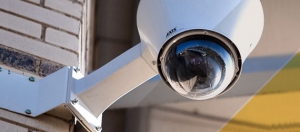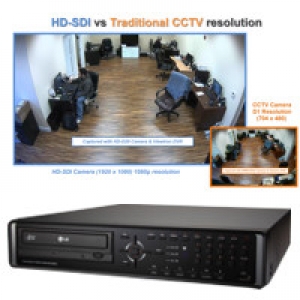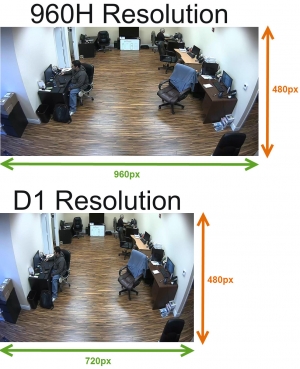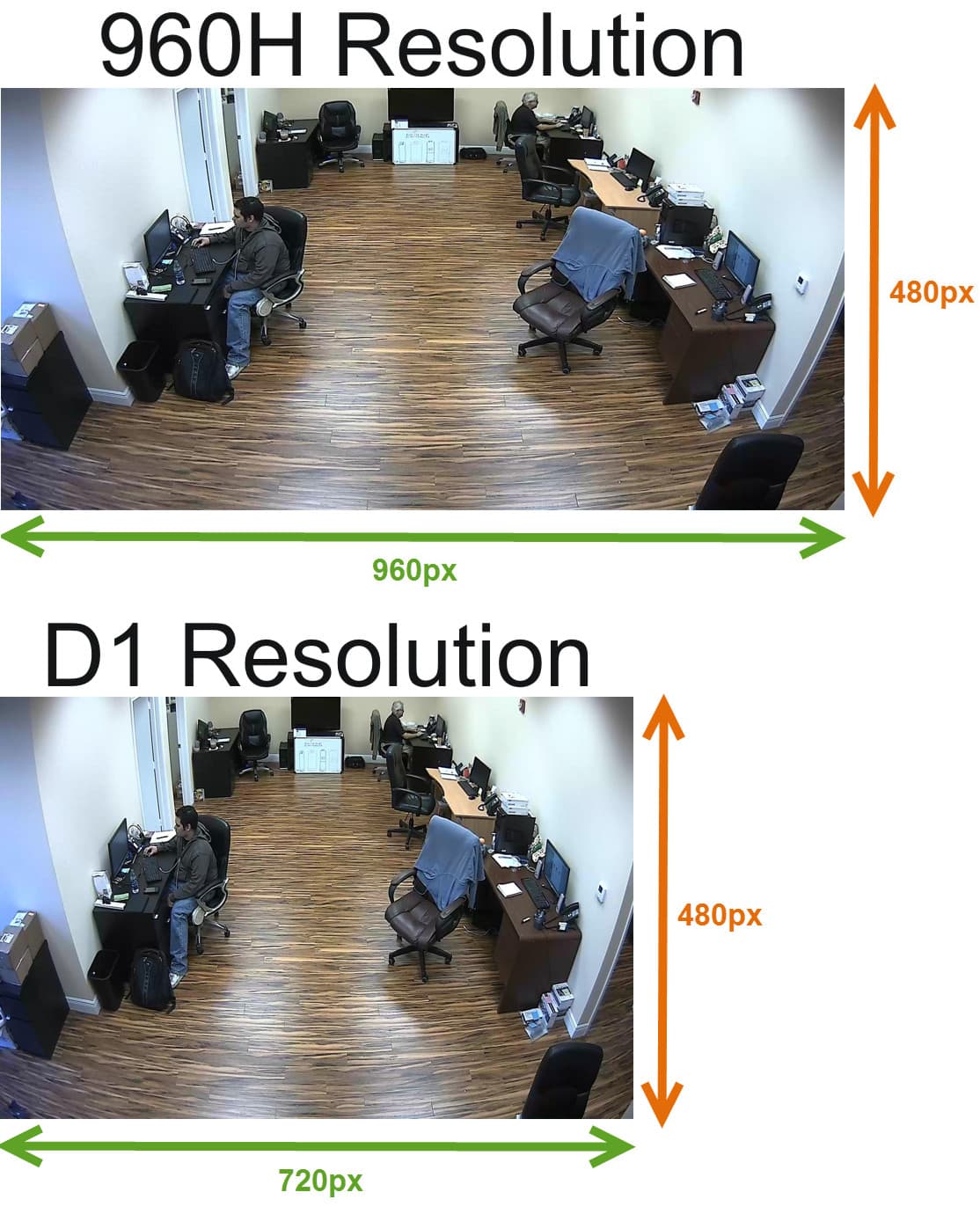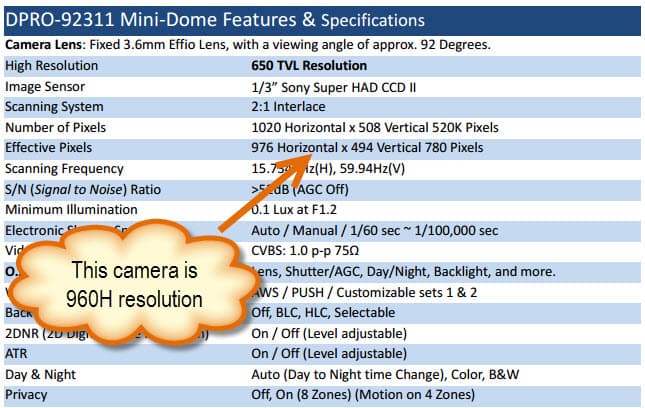High resolution
IP-based cameras are not restricted to the low resolution of analog cameras. With a 5-megapixel IP camera, you get ten times more detail in your images than with an analog 4CIF
Analog cameras have a maximum resolution of 704 x 480 pixels (4CIF). With an IP camera you can get increased resolution, including HDTV (720p/1080p) and even as high as 5 megapixels (2560 x 1920). This means you can either cover a much larger area in your scene, or get a highly detailed image to meet more demanding identification requirements.
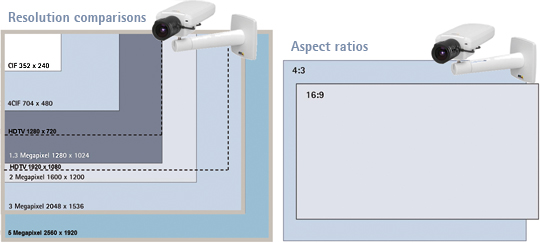
With IP-based cameras you also have the choice of various aspect ratios. This makes it easier to capture wide scenes and enables you to focus your coverage where it is most needed
![]()

With a high resolution camera you can select what you want to see; for example, you can choose large coverage in a store or extremely detailed information in a face
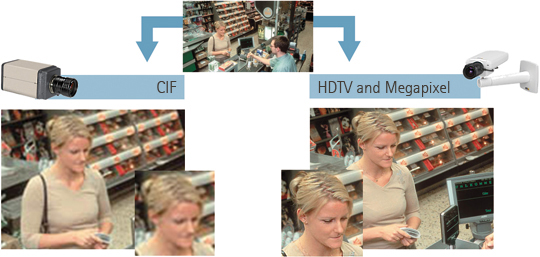
Truly digital
Unlike an analog video feed, the image from an IP camera will not degrade in quality when transported long distances or when converted between different formats. One IP camera can provide many simultaneous streams for viewing or storing in multiple locations
An analog signal will lose quality when it is transmitted over a distance and when it is converted. The digital signal will remain true – you will always have 100% quality. A single IP camera can also stream different parts of the image to different recipients at the same time, minimizing the need for bandwidth and storage
Installing one instead of multiple cameras minimizes installation and maintenance cost. Streaming of only selected areas minimizes bandwidth and storage need
Camera intelligence
IP cameras can do a lot more than just produce a video feed. Built-in intelligence enables cameras to perform a number of tasks to reduce pressure on operators, deliver vital business data and increase surveillance efficiency
By activating motion detection, the camera can trigger an event as soon as something happens in a scene. A built-in tampering alarm will notify the operator if the camera’s operation is disrupted
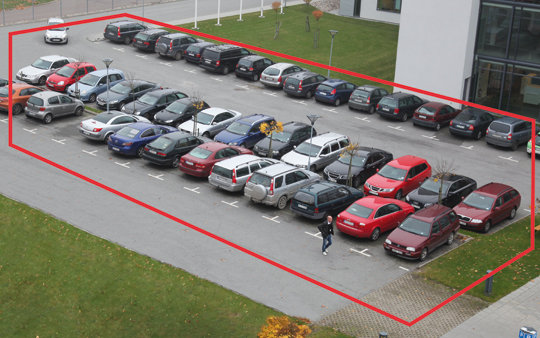
Another useful application is Cross Line Detection. This application detects moving objects that cross a virtual line, making it possible to automatically trigger an event
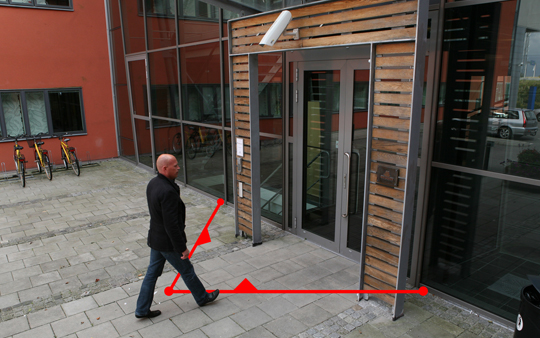
The functionality of IP cameras can be extended by adding new applications. The AXIS Camera Application Platform is an open application platform that enables development of third-party applications that can be downloaded and installed on Axis network cameras and video encoders
Fully integrated
An IP camera integrates power, video, audio, PTZ control and I/O in a single cable. That means cost savings, increased functionality and vast integration potential
With an analog PTZ camera, you need a separate cable to control the pan, tilt and zoom functions. If you add audio, you need yet another cable. Together with the power and video cables, this adds up to costly and inflexible camera infrastructure
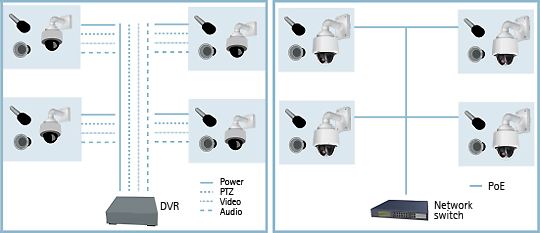
An IP camera not only requires less cabling; it also offers rich integration possibilities. By using the input or output ports on your camera, you can enable entrance control with or without the supervision of an operator. With built-in two-way audio, an operator can communicate verbally with a person standing in front of the camera. The camera can also use audio for detection, and trigger alarms or recordings
Built-in security
IP cameras offer encryption of the video feed as well as multilevel user access control. This means you can control exactly who can see what in your system, and your video is safe from any form of third-party manipulation.
Analog video is insecure. Lacking encryption or any means of authentication, the video feed from an analog camera can easily be tapped into, or even altered or replaced to disrupt the surveillance operation
Apart from HTTPS encryption and VPN support, the IP camera can also use IEEE 802.1x and IP address filtering. A digital watermark can be added to all recorded material
Crystal-clear motion
With an IP camera there are no interlacing problems. Using progressive scan, the entire image is captured each time, with superior image quality as a result
All cameras capture an image one line at a time. Most analog cameras use interlaced scanning. This means that only lines with odd numbers are scanned on the first pass, and the even-numbered lines are scanned on the next. The two subsets are then combined into one image. The problem with this is that any motion happening in between the passes will be blurry in the final image

1st field
Odd lines
2nd field: Even lines [17/20 ms (NTSC/PAL) later]
Freeze frame on moving dot using interlaced scan
Freeze frame on moving dot using progressive scan
IP cameras use progressive scan in which the entire image is scanned on every pass

At left, an image from an analog camera using interlaced scanning. At right, an image from an Axis network camera using progressive scan technology. Both cameras used the same type of lens and the speed of the car was the same at 20 km/h (15 mph). The background is clear in both images. However, the driver is clearly visible only in the image using progressive scan technology
Easy to scale
IP-based camera surveillance is easy to extend when the need arises. The cabling demands are far less complex than those for an analog system, and with a foundation of open standards you are not locked in to proprietary technology
Adding more cameras or functions to an analog system means a lot of new cabling, and matching the new equipment to your proprietary system could mean a limited selection from only one vendor.
Axis is a founding member of ONVIF, an open industry forum for the development of a global standard for the interface of IP-based physical security products. ONVIF ensures that IP-based equipment from different manufacturers can co-exist and interoperate on the same network
By using standard IP components, you ensure easy integration with other systems. You can easily route your video to wherever you need it from day to day, and cameras can be upgraded with intelligent plugins to extend functionality
Lower total cost
The total cost of ownership is lower for an IP-based system compared to an analog one. Even though analog cameras are less expensive to buy, the accompanying labor costs and expensive DVR equipment tip the scales in favor of IP cameras
In an independent integrator survey in 2010, bids for analog versus IP-based systems for a retail store with 14, 25 and 40 cameras were compared. The survey showed that the IP-based bids were consistently lower, and the difference increased with the number of cameras. With 40 cameras offered, the IP-based system cost 16% less than the analog one
Less cabling means less maintenance, and the open standard enables the use of inexpensive, off-the-shelf IT hardware for integrating functions
New possibilities
With an all IP-based surveillance system, you can grow with future challenges and opportunities. Open standards and a plugin architecture mean that your cameras can adapt to the latest technology
An IP-based system offers many advantages compared to an analog system. A Web interface in the camera enables easy access. System management and storage can be handled remotely. Axis cameras and encoders support the AXIS Video Hosting System (AVHS), making it possible to connect the network video product to a local service provider

Axis cameras can easily be upgraded, and system maintenance and overview are on camera level. Axis IP cameras with SD/SDHC cards or NAS provide efficient and affordable local storage and system redundancy
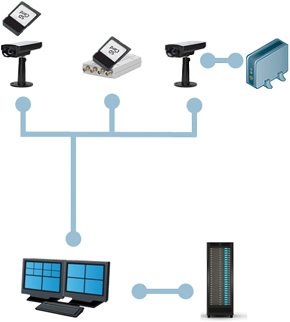
Easy to install
IP cameras connect easily into your existing data network. One cable per camera provides power, video and data, making it easy to install with minimum effort
By using your existing computer network you don’t need to invest in a new cabling infrastructure. With power over Ethernet (PoE) you don’t even need a power outlet in close proximity to your camera. And if your network switches are connected to redundant power, your cameras are too
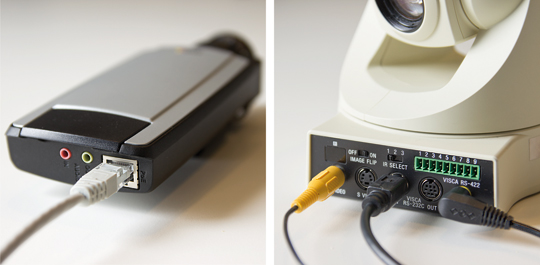
HD-SDI High Definition CCTV vs Traditional CCTV Cameras
HD-SDI CCTV cameras, also known as HD security cameras, are quickly gaining popularity as a high definition video surveillance solution. Until a few years ago, the only available option for high definition surveillance systems was to use network IP cameras which are typically more expensive and almost always more difficult to setup.
With the advent of HD-SDI technology for security cameras, users can now capture 1080p resolution video using the same RG59 or RG6 coaxial cable that is used by traditional CCTV cameras.
This new SDI platform is pivotal information for existing CCTV users whom have invested into expensive coaxial cabling installations, and now are in the market to upgrade their system to HD. These users are able to leverage their existing coax cable when they upgrade to HD Security cameras.
The HD-SDI paradigm also makes installation easier for many low voltage installers because HD-SDI security cameras follow the same plug and play processes as the traditional CCTV cameras, unlike IP cameras, which do require some level of networking knowledge to setup.
HD-SDI Camera vs. CCTV Camera Resolution
Traditional CCTV cameras are capable of resolutions up to about 704 x 480, which is referred to as D1 resolution, which is a hard limit that analog CCTV DVRs must abide by.
Some traditional CCTV cameras can actually capture slightly larger images than D1, but are unable to take advantage because traditional CCTV DVRs are limited to 704 x 480 resolution, which is why D1 is the accepted max resolution in the CCTV industry.
HD-SDI CCTV cameras are capable of true HD 1080p resolution (1920 x 1080). This higher resolution is the same as a high definition television and movies that consumers are use to. The SDI technology behind HD-SDI CCTV cameras is the same as the video cameras that capture video footage for “high def” motion pictures
HD-SDI and CCTV Images
The following image compares the image size and resolution of a high definition HD-SDI CCTV camera and standard definition CCTV camera. Please click on the image for the full sized view. After you click on the image, if your web browser supports zooming, you will probably be able to make the image even larger.

Here are the original images used in the above illustration. This high definition image was captured using a HD-B20 dome HD security camera.
.
This article explains what 960H video is and answers frequently asked questions about how 960H resolution is used in modern CCTV cameras and security DVRs.
What is 960H?
960H is the latest video resolution used by analog CCTV camera surveillance systems. The “H” in 960H stands for “horizontal” and 960 is the number of horizontal pixels in the video resolution. 960H is 960 x 480 video resolution. Unlike the generation of CCTV cameras and DVRs before 960H became a standard, 960H uses the 16:9 widescreen aspect ratio which makes it more suitable for use with modern widescreen format monitors and HDTVs. Almost all of modern monitors are 16:9 aspect ratio.
What resolution was used in CCTV before 960H?
Before 960H cameras and DVRs were available, the most popular video standard for CCTV systems was D1 resolution. D1 resolution is 720 x 480 pixels, sometimes D1 is 704 x 480 pixels. Notice that the width of the picture is wider when comparing 960H to D1, but the height is the same. D1 resolution uses a 4:3 aspect ratio which was much more popular 10 years ago, before the advent of widescreen monitors and high def television. CIF resolution (also shown in the top image on this page) is 360 x 240 (sometime 352 x 240). It is basically half the size of D1 and also uses the 4:3 aspect ratio. CIF resolution is typically used when bandwidth or recording hard drive space is limited.
960H vs D1
The below images compare 960H vs D1 video resolution. Please click on the image for a full sized view.
Do 960H cameras provide more video coverage than D1 cameras
No. The angle of view / view-able area covered by a security camera is determined by the size of the lens and the size of the image sensor (the electronic chip that actually captures the image). Almost all CCTV cameras use a 1/3 inch image sensor. This includes 960H and D1 format cameras. Lens sizes do vary. In the above images, a 3.6mm lens was used. Notice that although the 960H image is wider than the D1 image, the angle of view is the same. The wider format image does not mean that a wider angle of view is captured. It just means that more pixels were used and the picture is wider.
How do I know if a CCTV camera is 960H resolution
It is easy to confirm if a CCTV camera is 960H resolution by looking at the technical specification of the camera. Typically, there is a section in camera spec that documents the effective resolution of the camera in pixels. If the resolution width is 960 pixels or greater and the height is 480 pixels or greater, the camera is 960H. Below is a snapshot taken from the specification of a 960H camera.
Most CCTV cameras that are 960H resolution are 650 TVL or greater. TVL stands for television lines and is a another way to measure the resolution of analog cameras. You should not assume that all 650TVL or 700TVL cameras are 960H. In some cases, the image sensor of a 700TVL camera is not actually capable of capturing 960 x 480 pixels. You should always go by the effective pixels on the camera’s spec.
How can I use the new 960H format
In order to full take advantage of the 960H format in video surveillance applications, you should use both a 960H camera and a 960H DVR.
The above picture is a screenshot taken from an iDVR-PRO4A DVR (supports 960H video format) connected to 4 960H cameras. This is what the user sees from a monitor connected directly to the DVR’s VGA or HDMI video output. The DVR actually supports full 1080p monitor resolution, but unfortunately the video capture card that we used to grab this image only supports 720p resolution. Please click on the image for a full size view.
Can I use 960H cameras with a D1 DVR
Yes. Actually, 960H resolution cameras were available in the market before 960H DVRs were available. CCTV camera resolutions seem to always advance before DVR resolutions catch up. When you use a 960H camera with a D1 resolution DVR, the image is simply compressed by the DVR to fit the maximum resolution that the DVR supports. No view of the image is lost. The image as a whole is just shrunken down to fit. It makes sense for customers shopping for new CCTV cameras to purchase 960H cameras even if they do not plan on updating their DVR to 960H right now. When the time comes to replace their DVR, they will already have cameras that take advantage of the wider format resolution.
Can I use my older non-960H cameras with a 960H DVR
Yes. This is also a typical scenario. Many customers have existing CCTV cameras that are not 960H but provide a perfectly good picture that they are happy with. D1 / 4:3 apect ratio CCTV cameras will work fine with 960H DVRs. The DVR simply stretches the width of the image to fit the 960H resolution. This stretch is not drastic and most people do not even notice. 960H DVRs are backward compatible with non-960H cameras.
Do 960H and D1 cameras use the same cable
Yes, the same coax cable (typically RG59) is used for both 960H and D1 CCTV cameras. The same BNC video connectors are also used. The only differece is the size of the image that they capture. All of the same wiring can be used.
How does 960H compare to HD CCTV - HD-SDI
Although 960H cameras and HD-SDI cameras use the same type of coaxial cable (RG59 or RG6), they are two very different technologies. HD-SDI is a digital video signal and can support much higher resolutions than analog CCTV. HD-SDI cameras require HD-SDI recorders and support full 1080p video resolution. In this article, you can see a comparison of HD-SDI vs CCTV video resolution.

